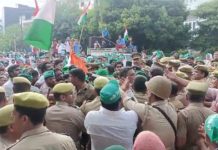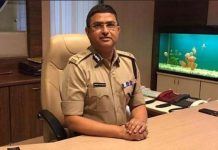
Nearly 300 years ago, Indian artists in princely courts were besieged by an influx of European artists seeking their fortunes in India. Lured by the prospect of painting the fabled maharajas and nawabs, these artists — mostly flocking from Britain, France and Portugal — brought along European styles of art. Suddenly the traditional watercolour miniature, a form most Indian artists preferred to worked in, was rendered obsolete by the luscious oil-on-canvas. Thus Indian artists turned to portrait painting.
Having researched extensively on the subject and digging around several important sites in the country, the Delhi Art Gallery (DAG) has now put together a show of portraits spanning 250 years. Indian Portraits: The Face of a People is as much an anthropological exercise as it is an art show. For the DAG, though, it is part of a larger mission to research, archive and document the history of Indian art and restore what curator Kishore Singh calls “a continuity we lost with our art traditions under the British”.
Here, under one roof, is a period of tumultuous change in art styles. The growing demand for portraits produced many greats such as Raja Ravi Varma. Their subjects, though, were no longer men, but also women, who increasingly began to come out of their purdah — first the courtesans, then the elites and the royals. The Parsis, the most Westernised of Indians, were the first to commission portraits of women. Some of the finest works came from the Bombay Presidency artists, with NR Sardesai producing magnificent portraits. Looking at Sardesai’s painting of his sister, Singh points out, “This could be a Rembrandt.”
When the modernists took the reins, they broke away from the realist template to paint more psychological portraits, a phenomenon that began with Rabindranath Tagore and gained greatest momentum in the hands of FN Souza. No longer was the physical likeness that Varma’s school perfected important. The lines were now distorted. Tagore’s androgynous painting of Kadambari Devi and Sunil Das’ haunting Pushpa are fine examples: the face is no longer as significant as the artist’s impression of it. Tagore’s works, though, are more ambiguous. “You cannot exactly call his work portraits in the academic sense. It’s often his own fantasy being painted on canvas,” says art critic Ella Datta. The same goes for the Kolkata-based artist Rabin Mondal, who, Singh says, showed “the venal quality of mankind”.
He points out that the previous artists did not have the luxury to experiment. “They worked largely for commissions and had to paint what their subjects liked,” he says. The most coveted commissions were, of course, those of the Indian royals, but more often than not they turned out to be tricky. Singh offers several anecdotes his team unearthed during their research. To begin with, the lure of painting the Nawabs of Arcot and Awadh brought European artists in droves from Madras and Calcutta. But such personages were neither used to posing for hours nor to listening to white men. Even Raja Ravi Varma was once denied a sitting by the Nawab of Hyderabad. On the other hand, the Indian artists keen to pick up the trade would make basic mistakes like painting a child out of proportion or a poor-quality horizon.
The advent of photography was another game changer. Studio photographers often employed painters to paint over the photographs, giving them imaginary backgrounds that the subjects picked. Additionally, “It was no longer the elites who could record themselves; now even the masses could get their pictures taken,” says Datta. With an increasing number of people getting photographed or painted, more ways of looking at genders, communities and classes emerged. “What are the patterns of clothing in different places, why is one maharaja dressed like this and not another, what is a family’s background, we can look at these images from different points of view,” says Singh.
The exhibition brings together a multitude of tales. Tales of people, places, societies and traditions. As a viewer makes his way from one lushly painted canvas to another, surrounded by the stately royals, artists’ self-portraits endowed with heroism, and even a bold caricature of Jawaharlal Nehru, it becomes the most captivating walk through history.
The exhibition is on display till 26 October at Delhi Art Gallery
aradhna@tehelka.com













